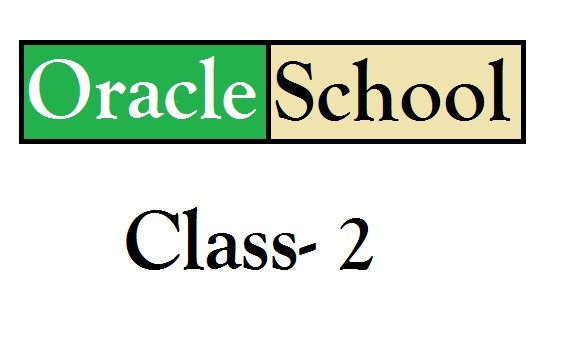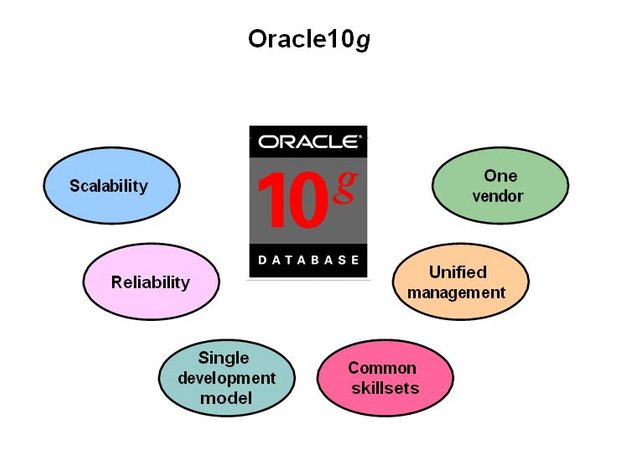Learn programming at Steemit Oracle School # Class 2 (Oracle Profile)

Profile
Before You Begin This Course
Before you begin this course, you should be able to use a graphical user interface (GUI). The prerequisite is a familiarity with data processing concepts and techniques.
How This Course Is Organized
Oracle Database 10g: SQL Fundamentals I is an instructor-led course featuring lectures and hands-on exercises. Online demonstrations and written practice sessions reinforce the concepts and skills that are introduced.
Typographic Conventions
The following two lists explain Oracle University typographical conventions for words that appear within regular text or within code samples.
1. Typographic Conventions for Words Within Regular Text
| Convention | Object or Term | Example |
|---|---|---|
| Courier New | User input, commands; column, table, and schema names; functions; PL/SQL objects; paths | Use the SELECT command to view information stored in the LAST_NAME column of the EMPLOYEES table. Enter 300. Log in as scott. |
| Initial cap | Triggers; user interface object names, such as button names | Assign a When-Validate-Item trigger to the ORD block. |
| Italic | Titles of courses and manuals; emphasized words or phrases; placeholders or variables | For more information on the subject see Oracle SQL Reference Manual. |
Lesson Objectives
After completing this lesson, you should be able to do the following:
• List the features of Oracle10g
• Discuss the theoretical and physical aspects of a relational database
• Describe the Oracle implementation of RDBMS and ORDBMS
• Understand the goals of the course
Objectives
In this lesson, you gain an understanding of the relational database management system (RDBMS) and the object relational database management system (ORDBMS). You are also introduced to the following:
• SQL statements that are specific to Oracle
• SQL Developer, which is an environment used for executing SQL statements and for formatting and reporting purposes.
Goals of the Course
After completing this course, you should be able to do the following:
• Identify the major structural components of Oracle Database 10g
• Retrieve row and column data from tables with the SELECT
statement
• Create reports of sorted and restricted data
• Employ SQL functions to generate and retrieve customized data
• Run data manipulation language (DML) statements to update data in Oracle Database 10g
• Obtain metadata by querying the dictionary views
Goals of the Course
This course offers you an introduction to Oracle Database 10g database technology. In this class, you learn the basic concepts of relational databases and the powerful SQL programming language. This course provides the essential SQL skills that enable you to write queries against single and multiple tables, manipulate data in tables, create database objects, and query metadata.
Oracle10g Features
The Oracle10g release offers a comprehensive high-performance infrastructure, including:
• Scalability from departments to enterprise e-business sites
• Robust, reliable, available, and secure architecture
• One development model; easy deployment options
• Leverage an organization’s current skillset throughout the Oracle platform (including SQL, PL/SQL, Java, and XML)
• One management interface for all applications
• Industry-standard technologies; no proprietary lock-in
In addition to providing the benefits listed above, the Oracle10g release contains the database for the grid. Grid computing can dramatically lower the cost of computing, extend the availability of computing resources, and deliver higher productivity and quality.
The basic idea of grid computing is the notion of computing as a utility, analogous to the electric power grid or the telephone network. As a client of the grid, you do not care where your data is or where your computation is done. You want to have your computation done and to have your information delivered to you when you want it. From the server side, grid is about virtualization and provisioning. You pool all your resources together and provision these resources dynamically based on the needs of your business, thus achieving better resource utilization at the same time.
Oracle10g
The three grid-infrastructure products of the Oracle10g release are:
• Oracle Database 10g
• Oracle Application Server 10g
• Oracle Enterprise Manager 10g Grid Control
Oracle Database 10g
Oracle Database 10g is designed to store and manage enterprise information. Oracle Database 10g cuts management costs and provides a high quality of service. Reduced configuration and management requirements and automatic SQL tuning have significantly reduced the cost of maintaining the environment.
Oracle Database 10g contributes to the grid-infrastructure products of the Oracle 10g release. Grid computing is all about computing as a utility. If you are a client, you need not know where your data resides and which computer stores it. You should be able to request information or computation on your data and have it delivered to you.
Oracle Database 10g manages all your data. This is not just the object-relational data that you expect an enterprise database to manage. It can also be unstructured data such as:
• Spreadsheets
• Word documents
• PowerPoint presentations
• XML
• Multimedia data types like MP3, graphics, video, and more
The data does not even have to be in the database. Oracle Database 10g has services through which you can store metadata about information stored in file systems. You can use the database server to manage and serve information wherever it is located.
Oracle Application Server 10g
Oracle Application Server 10g provides a complete infrastructure platform for developing and deploying enterprise applications, integrating many functions including a J2EE and Web services run-time environment, an enterprise portal, an enterprise integration broker, business intelligence, Web caching, and identity management services.
Oracle Application Server 10g adds new grid computing features, building on the success of Oracle9i Application Server, which has hundreds of customers running production enterprise applications.
Oracle Application Server 10g is the only application server to include services for all the different server applications that you might want to run, including:
• Portals or Web sites
• Java transactional applications
• Business intelligence applications
It also provides integration among users, applications, and data throughout your organization.
Oracle Enterprise Manager 10g Grid Control
Oracle Enterprise Manager 10g Grid Control is the complete, integrated, central management console and underlying framework that automates administrative tasks across sets of systems in a grid environment. With Oracle Grid Control, you can group multiple hardware nodes, databases, application servers, and other targets into single logical entities. By executing jobs, enforcing standard policies, monitoring performance, and automating many other tasks across a group of targets instead of on many systems individually, Grid Control enables scaling with a growing grid.
Software Provisioning
With Grid Control, Oracle 10g automates installation, configuration, and cloning of Application Server 10g and Database 10g across multiples nodes. Oracle Enterprise Manager provides a common framework for software provisioning and management, enabling administrators to create, configure, deploy, and utilize new servers with new instances of the application server and database as they are needed.
Application Service Level Monitoring
Oracle Grid Control views the availability and performance of the grid infrastructure as a unified whole, as a user would experience it, rather than as isolated storage units, processing boxes, databases, and application servers.
Relational and Object Relational Database Management Systems
- Relational model and object relational model
- User-defined data types and objects
- Fully compatible with relational database
- Support of multimedia and large objects
- High-quality database server features
About the Oracle Server
The Oracle server supports both the relational and object relational models.
The Oracle server extends the data-modeling capabilities to support an object relational database model that brings object-oriented programming, complex data types, complex business objects, and full compatibility with the relational world.
It includes several features for improved performance and functionality of online transaction processing (OLTP) applications, such as better sharing of run-time data structures, larger buffer caches, and deferrable constraints. Data warehouse applications benefit from enhancements such as parallel execution of insert, update, and delete operations; partitioning; and parallel-aware query optimization. Operating within the Network Computing Architecture (NCA) framework, the Oracle model supports client/server and Web-based applications that are distributed and multitiered.
For more information about the relational and object relational model, see the Database Concepts
manual.
Oracle Internet Platform
To develop an e-commerce application, you need a product that can store and manage the data, a product that can provide a run-time environment for your applications implementing business logic, and a product that can monitor and diagnose the application after it is integrated. The Oracle 10g products provide all the necessary components to develop your application.
Oracle offers a comprehensive high-performance Internet platform for e-commerce and data warehousing. The integrated Oracle Internet Platform includes everything needed to develop, deploy, and manage Internet applications, including these three core pieces:
• Browser-based clients to process presentation
• Application servers to execute business logic and serve presentation logic to browser-based clients
• Databases to execute database-intensive business logic and serve data
Oracle offers a wide variety of the most advanced graphical user interface (GUI)–driven development tools to build business applications, as well as a large suite of software applications for many areas of business and industry. Oracle Developer Suite includes tools to develop forms and reports and to build data warehouses. Stored procedures, functions, and packages can be written using SQL, PL/SQL, or Java.
System Development Life Cycle
From concept to production, you can develop a database by using the system-development life cycle, which contains multiple stages of development. This top-down, systematic approach to database development transforms business information requirements into an operational database.
Strategy and Analysis Phase
• Study and analyze the business requirements. Interview users and managers to identify the information requirements. Incorporate the enterprise and application mission statements as well as any future system specifications.
• Build models of the system. Transfer the business narrative into a graphical representation of business information needs and rules. Confirm and refine the model with the analysts and experts.
Design Phase
Design the database based on the model developed in the strategy and analysis phase.
Build and Documentation Phase
• Build the prototype system. Write and execute the commands to create the tables and supporting objects for the database.
• Develop user documentation, help text, and operations manuals to support the use and operation of the system.
System Development Life Cycle (continued)
Transition Phase
Refine the prototype. Move an application into production with user-acceptance testing, conversion of existing data, and parallel operations. Make any modifications required.
Production Phase
Roll out the system to the users. Operate the production system. Monitor its performance, and enhance and refine the system.
Note: The various phases of the system development life cycle can be carried out iteratively. This course focuses on the Build phase of the system development life cycle.

Class-2 Finished. To Be Continued...

Have you voted for your witness?
Consider casting your witness votes for @steemgigs (@surpassinggoogle), @acidyo, @blocktrades, @cloh76.witness, @ausbitbank, @enginewitty, @noblewitness and @curie who have been adding invaluable contribution to the community.
To cast your votes, just go to
https://steemit.com/~witnesses
If you don't find their name in list then type the userame and click vote.








You got a 9.49% upvote from @dailyupvotes courtesy of @aaarif!